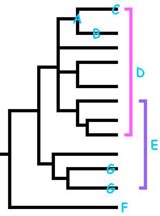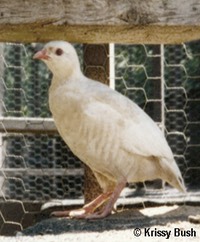Population Genetics Definitions
• Adaptation = A trait that increases the survivability of an individual or its ability to reproduce when compared to individuals that do not possess that trait
• Adaptive Radiation = Radiation of a group of organisms into populations adapted to exploit different ecological niches
• Adaptive Trait = A trait that increases the fitness of an individual
• Allopatric Speciation = Speciation that occurs when populations become geographically isolated due to genetic drift and when selection pressures differ between the two populations
• Assortative Mating = A mating pattern that occurs when individuals tend to mate with other individuals of the same genotype and phenotype
• Bottleneck = A large scale but short term decrease in the population size followed by an increase in the population size. Can cause speciation events
• Convergent Evolution = Similarities between species that are the result of similar, but evolutionarily independent responses to common environmental factors. E.g. The wing of a bird and the wing of a butterfly
• Evolution = Descent with modification = a change in the characteristics of a population over time = changes in the allele frequency of a population over time
• Fitness = The degree to which an individual contributes genes to the next generation
• Founder Effect = The establishment of a new population by a small number of individuals. can cause speciation events
• Frequency = The proportion of a genotype, phenotype, gamete, or allele in a population. E.g. 6/10 have brown hair = a frequency of 0.6
• Gene Pool = All of the copies of all of the alleles in a population that could be contributed by members of the present generation to members of the next generation
• Genetic Drift = A change in the allele frequency of a population resulting from sampling error in taking gametes from the gene pool to make zygotes and from chance variation in the survival/reproductive success of individuals
• Hardy-Weinberg Equilibrium = An ideal population in which the allele and genotype frequencies do not change from one generation to the next generation due to a lack of selection, mutation, migration, and genetic drift and due to the occurrence of random mating
• Heritability = The fraction of the total phenotypic variation in a population that is caused by genetic differences between individuals
• Homology = Similarities between species that results from the inheritance of traits from a common ancestor
• Homoplasy = Similarities in the traits found in different species that is due to convergent evolution, parallelism, or reversal. It is not due to common descent
• Hybrid Zone = A geographic zone where different populations/species interbreed
• Inbreeding = Mating between relatives
• Inbreeding Depression = A decrease in the fitness of an individual or a population due to inbreeding. It is often the result of a decrease in heterozygosity of an increase in the homozygosity (both are due to inbreeding)
• Inclusive Fitness = An individual's total fitness = indirect fitness (fitness due to the reproduction by relatives made possible by that individual) + direct fitness (fitness due to the individual's own reproduction)
• Macroevolution = Large scale evolutionary change = evolution of the differences between populations that would justify their placement into different genera (or higher level taxa)
• Microevolution = Changes in the gene frequencies and trait distributions that occur within species and populations
• Migration = The movement of alleles from one population to another population due to the movement of individuals or gametes
• Natural Selection = Specific phenotypes confer increased survivability or reproductive success to the individuals that possess them
• Negative Selection = Selection against deleterious mutations
• Outbreeding = Mating between unrelated individuals
• Polymorphism = The existence of more than one allele or variant in a population
• Population = A group of individuals capable of interbreeding plus all of their offspring
• Positive Selection = Selection for advantageous mutations
• Preadaptation = A trait that changes due to natural selection and takes on a new function
• Relative Fitness = The fitness of an individual, phenotype, or genotype compared to other individuals in the population
• Species = Groups of populations that are capable of interbreeding and are evolutionarily independent from other populations
• Sympatric Speciation = A speciation event involving species living in the same geographic area
• Synapomorphy = A shared derived trait
• Transitional Form = A species exhibiting traits that are common to both the ancestral and derived groups
Phylogenetics Definitions
• Bootstrapping = A term commonly used in phylogenetic reconstruction = A technique used for estimating the strength of evidence for the existence of a particular node in a phylogenetic tree. Values range between 0% and 100% with 100% being the strongest level of support
• Branch = A branch in a phylogenetic tree. See diagram
• Clade = A group of species descended from a common ancestor = a monophyletic group
• Evolution = Descent with modification = a change in the characteristics of a population over time = changes in the allele frequency of a population over time
• Extant = Living today
• Extinct = Not living today
• Monophyletic Group = A population of a group of species descended from a common ancestor
• Node = Branching point in a phylogenetic tree. See diagram
• Outgroup = In phylogenetic analysis, a group that diverged prior to the rest of the taxa
• Paraphyletic Group = A group of species that includes the common ancestor and some, but not all of that common ancestor's descendants
• Phylogeny = The evolutionary history of a group
• Psuedogene = DNA sequences that are homologous and resemble functioning genes, but are not transcribed
• Sister Species = Species that diverged from the same node on a phylogenetic tree
• Species = Groups of populations that are capable of interbreeding and are evolutionarily independent from other populations
• Taxon = Any named group of organisms
• Tip = The end of a branch on a phylogenetic tree. See diagram

A = Node
B = Branch
C = Tip
D = Monophyletic Group
E = Paraphyletic Group
F = Outgroup
G = Sister Taxa/Species
References
• Freeman, S. and Herron, J. C. 2001. Evolutionary Analysis Second Edition. Prentice-Hall, Inc. New Jersey.
• Griffiths, A. J. F., Miller, J. H., Suzuki, D. T., Lewontin, R. C., and Gelbart, W. M. 1996. An Introduction to Genetic Analysis Sixth Edition. W.H. Freeman and company. New York.
